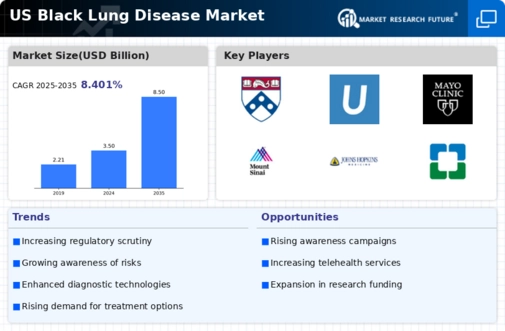Technological Innovations in Treatment
Technological advancements in treatment modalities for black lung disease are emerging as a key driver in the black lung-disease market. Innovations such as improved respiratory therapies and advanced imaging techniques are enhancing the diagnosis and management of the disease. For example, the introduction of portable diagnostic devices has made it easier for healthcare providers to assess lung function in miners, leading to timely interventions. The market for these technologies is projected to grow at a CAGR of 15% over the next five years, indicating a robust demand for innovative solutions. As healthcare systems increasingly adopt these technologies, the black lung-disease market is likely to experience significant growth, driven by the need for effective treatment options and improved patient outcomes.
Legislative Changes and Support Programs
Recent legislative changes aimed at enhancing support for miners suffering from black lung disease are likely to influence the black lung-disease market significantly. The U.S. government has introduced various programs to provide financial assistance and healthcare benefits to affected individuals. For instance, the Black Lung Benefits Act offers compensation to miners who are diagnosed with the disease, which has led to an increase in claims and, consequently, a higher demand for medical services related to black lung disease. This legislative support not only aids in the financial stability of affected miners but also encourages healthcare providers to invest in specialized treatment options, thereby expanding the black lung-disease market. The potential for further legislative initiatives may continue to shape the landscape of this market in the coming years.
Rising Awareness of Occupational Health Risks
The increasing awareness of occupational health risks associated with coal mining and other industries has a profound impact on the black lung-disease market. As more individuals become informed about the dangers of prolonged exposure to coal dust, there is a growing demand for preventive measures and treatment options. This heightened awareness is reflected in the rising number of reported cases, which has surged by approximately 20% over the past decade. Consequently, healthcare providers and policymakers are focusing on improving screening and diagnostic services, thereby driving growth in the black lung-disease market. Furthermore, educational campaigns aimed at miners and their families are likely to enhance early detection and intervention, which could lead to better health outcomes and increased market demand for related healthcare services.
Increased Funding for Research and Development
The black lung-disease market is poised for growth due to increased funding for research and development initiatives focused on understanding and treating the disease. Government agencies and private organizations are allocating substantial resources to study the long-term effects of coal dust exposure and to develop new therapeutic approaches. In recent years, funding for research in this area has risen by approximately 30%, reflecting a commitment to addressing the health challenges faced by miners. This influx of capital is expected to foster innovation in treatment options and diagnostic tools, thereby expanding the black lung-disease market. As new findings emerge, they may lead to more effective interventions, ultimately benefiting patients and healthcare providers alike.
Growing Demand for Comprehensive Healthcare Services
The increasing prevalence of black lung disease is driving a growing demand for comprehensive healthcare services tailored to affected individuals. As the number of diagnosed cases rises, healthcare systems are adapting to provide specialized care, including pulmonary rehabilitation and psychological support. This trend is evident in the establishment of dedicated clinics and programs aimed at addressing the multifaceted needs of patients. The black lung-disease market is likely to benefit from this shift towards holistic care, as it encourages the development of integrated treatment plans that encompass both physical and mental health. Furthermore, the emphasis on comprehensive services may lead to increased patient engagement and adherence to treatment protocols, ultimately improving health outcomes and market growth.



















Leave a Comment